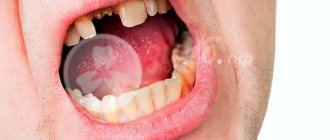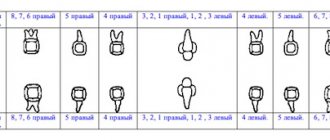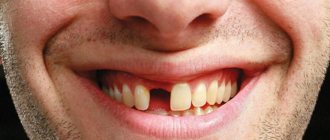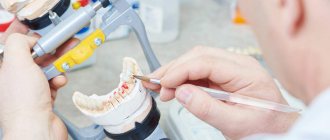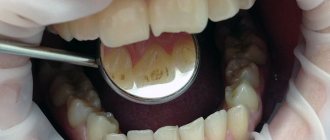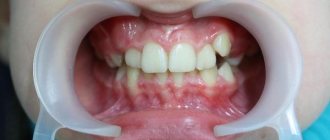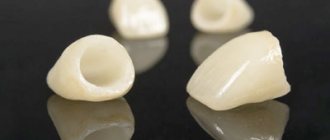Dentists spend a lot of time developing methods to maintain not only a healthy, but also a beautiful smile. Aesthetic dentistry is a special direction in which the main efforts are aimed at restoring the natural beauty of teeth. One of the common methods used for this purpose is tooth restoration with composite material .
The procedure involves the installation of modern, individually selected photopolymer fillings that are indistinguishable from natural teeth even by dentists. In St. Petersburg, the service is provided by the Nurimed clinic, where experienced doctors work who take on clinical cases of any complexity. You can make an appointment or clarify the information you are interested in by calling: +7 (965) 067-04-26, or via online chat.
Who is undergoing the procedure?
Anyone can sign up for artistic restoration of the dentition or part of it. Common indications for restoration techniques:
- Cracks;
- Chips;
- Partial destruction;
- Carious lesions of varying neglect;
- Non-carious lesions that change the appearance of the dentition;
- Darkening of the enamel;
- The appearance of black spots on the teeth;
- Blackening or any other discoloration of the enamel.
If the client is dissatisfied with the external condition of the teeth, then Nurimed dentists will make an aesthetic restoration. At the same time, each patient is comprehensively examined, excluding contraindications to the procedure.
Contraindications for use
The production of veneers is contraindicated if:
- caries is not cured;
- teeth are weakened due to gum disease or another reason;
- the enamel on the tooth is too thin;
- teething has not yet completed;
- the patient has a straight bite;
- The patient has bruxism (grinding or clenching of teeth).
Ceramic veneers are not installed on teeth with caries and when diagnosing periodontal diseases, otherwise the teeth under the veneer will quickly deteriorate. Installation of veneers is possible only after complete recovery from these diseases.
Porcelain veneers require grinding of the tooth, and if the enamel is already severely damaged by caries or has a serious chip, installing a veneer is not recommended - it will weaken the already fragile tooth, which will lead to its complete destruction. These teeth are restored using dental crowns. It is also not recommended to use veneers on teeth with a thin layer of enamel - it will not be enough to provide the necessary strength of the veneer.
The production of veneers is also contraindicated for bruxism: porcelain plates easily break due to excessive load when grinding teeth.
To whom is the technique contraindicated?
Artistic restoration of teeth with composite material is not possible for all clients, since the technique has a number of contraindications (some of them are temporary and correctable):
- Allergic reaction to the composite;
- Installed pacemaker;
- Some individual characteristics that prevent the sealing of a carious cavity;
- Poor oral hygiene;
- Night grinding of teeth (bruxism);
- Pathological bite;
- Excessive abrasion of tooth enamel;
- Frequent stay in traumatic conditions (athletes, rescuers, etc.).
By registering with Nurimed, clients can be calm about their own safety and the results of the procedure, since the clinic’s doctors individually assess the risks and benefits for everyone.
Methods for making veneers
- Injection pressing followed by sintering of ceramic mass (Dicor, IPS Empress);
- Vacuum firing on a refractory model (refractor);
- Milling on a computer-controlled machine from ready-made factory blocks - CAD/CAM (computer aided design and manufacturing). These are systems such as Cerec, Everest Procera, Cercon and In-Ceram, Vollceram, Hi-Ceram masses.
Advantages and disadvantages of veneers
Advantages of the method
Our dental center prefers composite correction for patients due to a number of its advantages:
- An ideal aesthetic result, since it is possible to select a material that completely imitates natural tooth enamel.
- Helps to correct not only external beauty, but also restore chewing function. After restoration, a person can eat any food without fear of pain or discomfort.
- The correction speed is high. One visit to the dentist is enough to restore several teeth. Especially when it comes to a modernly equipped clinic.
- Allows you to preserve the maximum amount of healthy tissue. A very gentle option for restoring a smile.
- Moderate cost of the service. Despite a number of listed advantages, the price of restoration remains affordable to every client.
Veneer manufacturing sequence
Veneers require individual care! Avoid lever-like movements when biting food
- Determination of indications;
- Cleaning teeth from plaque, determining color;
- Photographic registration of images of the patient's face in front and profile with the mouth open and closed in the anterior region (this information helps the technician in planning future restoration);
- Taking diagnostic impressions and making models, recording central occlusion (habitual closure of the dentition);
- Wax planning of future restoration (WaxUp);
- Production of temporary veneers (if preparation is planned);
- Preparation with depth marking (the goal is to remove only the minimum volume of enamel necessary for applying and fixing the facets;
- Taking final working impressions, re-registration of central occlusion, temporary fixation of temporary structures made of composite or acrylic plastic;
- Production of veneers in a dental laboratory or milling center;
- Removal of temporary restorations;
- Application and fitting of the finished structure, assessment of quality, accuracy of marginal fit, contact with adjacent teeth and antagonists (teeth of the opposite jaw);
- Cleaning and preparing the tooth surface and veneers for permanent fixation;
- Isolation of the working field;
- Fixation with dual-curing composite cement (light and chemical);
- Removing excess material;
- Check and, if necessary, correct contacts.
Disadvantages of composite restoration
Each technique, therapeutic or aesthetic, has its drawbacks. For direct composite dental restoration this is:
- The resulting ideal color of the composite lasts approximately 3-4 years.
- The service life of new fillings is not long enough compared to porcelain material.
- Increased risk of formation of secondary carious lesions in comparison with ceramic structures.
- If the volume of restoration is very large, then this affects the strength. Ceramics are considered more reliable.
There is also a risk of choosing the wrong shade of the composite, which will differ from real enamel. However, the high qualifications and extensive experience of our dentists exclude such an unpleasant situation.
Fast and predictable restoration of posterior teeth
November 21, 2013
In most cases, when filling cavities localized in the lateral group of teeth, dentists pay insufficient attention to modeling the anatomical shape of the tooth. Certain difficulties arise due to limited time at a dental appointment. An incorrectly placed filling can become the source of many problems: injury to the gums and papilla, mucous membrane of the cheek and lip, tongue - this is not a complete list of possible complications. Even one restoration can cause dysfunction of the temporomandibular joint, especially if the occlusal-articulatory relationship is inadequately corrected. However, restoring the anatomical shape of the chewing surface should be one of the main tasks.
The appearance on the market of modern high-tech composite materials and new methods for restoring the chewing surface of the lateral group of teeth greatly facilitates the production of restorations with impeccable aesthetic characteristics. The desire to combine aesthetics with functionality is reflected in the silicone template technique, which is quite simple in content. It is enough to take an impression of the tooth before removing necrotic tissue, then prepare the tooth, add material and form the required surface with the previously obtained silicone negative. The crown of the teeth of the lateral group has a very complex configuration.
Fig. 1 Hidden carious cavity of tooth 36
Most often, caries develops in fissures, since the slopes of the cusps surrounding the fissures are buffer zones available for self-cleaning. In addition, as a result of the widespread use of remineralizing drugs and fluoride-containing toothpastes, caries is increasingly diagnosed when there is a discrepancy between the absence of surface changes on the tooth and extensive damage to deeper tissues.
Let's consider one of the methods for restoring the occlusal surface of the chewing group of a tooth using a clinical example. So, patient A., 26 years old, went to a therapeutic dentistry clinic for a preventive examination. After the examination, the presence of a carious cavity in tooth 36, class 1 according to Black, was revealed (Fig. 1)
Often, after preparation, a deep cavity is formed, which can be restored in two ways: the sandwich technique or the layer restoration technique. Due to the labor-intensive, multi-step nature, large amounts of time spent, as well as problems arising as a result of polymerization stress, these methods cause difficulties.
The solution to these problems is facilitated by the Bulk filling technique, which provides for the immediate replenishment of missing dentin with the subsequent restoration of the enamel layer with a traditional composite. A new material, SDR™, was developed for this technique. The main and surprising property of this material is the possibility of one-volume restoration of missing dentin in a portion
Fig.2 Manufactured silicone key
up to 4 mm, which significantly reduces the time and labor intensity of direct restoration. This was made possible through the use of a proprietary cross-linking resin, which significantly reduces the polymerization stress in the material structure. In other words, during polymerization, SDR™ gives the traditional shrinkage for all composites, but there is practically no stress or compressive forces in the material.
To restore the enamel layer, the new universal hybrid composite VersaCOMP (Sultan Healthcare) can be used. Due to the improved formula, it has an optimally fluid consistency, which subsequently makes it possible to achieve a high-quality marginal fit of the restoration. This material is easy to use, easy to model and distribute. It has a natural aesthetics, adapting to the surrounding tooth structures. When using this technique, after anesthesia is performed, a silicone key is removed from the occlusal surface of the tooth (Fig. 2).
Fig.3 Rubber dam applied to tooth 36
Next, a rubber dam is applied (Figure 3) and the carious cavity is prepared. After medicinal treatment of the carious cavity with a 2% chlorhexidine solution, the cavity is conditioned using VersaCOMP Etch Gel (Sultan Healthcare), (Fig. 4), washed and slightly dried to preserve moist dentin. As a result of total etching, the enamel becomes micro-rough, the smear layer on the dentin surface dissolves and is completely removed, the surface layers of dentin are demineralized, collagen fibers are exposed, and dentinal tubules open [Nikolaev A.I., Tsepov L.M., 2011].
Fig.4 Conditioning of the cavity is carried out
The next step is adhesive preparation of the cavity. VersaComp material comes with a universal adhesive. It is tolerant to dry and wet environments and is effective immediately after drying for 10 seconds. The material provides complete control over the adhesive preparation procedure. It is recommended to lightly rub the applied adhesive into the etched tissues and pause for 30 seconds to allow the adhesive to penetrate into the dentin to the full depth of its demineralization and prevent nanoleakage. The adhesive is then flashed for 20 seconds.
Fig.5 A layer imitating dentin has been added
Next, SDR™ material is applied to the entire volume of dentin up to a depth of 4 mm. Having a fluid consistency, the material fills all the undercuts of the cavity, demonstrating its inherent “self-leveling” property (Figure 5). We shine for 20 seconds. Next, the anatomical shape of the tooth is restored using the VersaCOMP composite and a silicone template removed in advance. The restoration of the cusps of a given tooth is carried out alternately with the application of a silicone template, that is, the non-polymerized material is pressed with a silicone template, and then the correct shape of the cusp is thus formed.
When the template is fitted to the tooth, excess material comes out through the drainage channels, then the silicone template is removed from the oral cavity. After assessing the occlusal surface, cusp restoration continues if necessary. If the desired result is obtained, the composite is photopolymerized. The good handling qualities of the material and the lack of sticking to the template allow you to quickly recreate the natural relief of the occlusal surface (Fig. 6), which practically does not require editing according to the bite. Next comes the final processing of the filling, its grinding and polishing.
Thus, the use of the SDR™ material and the VersaCOMP material to restore the cavities of the posterior group of teeth, as well as the silicone template technique, makes it possible to quickly create a reliable restoration, which will improve the quality of aesthetic restorations. The manufactured structures closely resemble the patients’ natural teeth. This reduces the number of complications associated with unaesthetics and dysfunction of structures, as well as their adverse effects on periodontal tissue.
|
|
see also
March 11, 2012
VersaCOMP restorative materials
We are pleased to announce that UNIDENT now exclusively presents VersaCOMP restorative materials from Sultan Healthcare. The line includes a full range of restorative materials that are distinguished by their versatility, ease of modeling and excellent clinical performance. This makes working with Versacomp comfortable and the results durable. Return to section
Types of procedure
The choice of dental restoration technique depends on the individual characteristics of the clinical case. The following factors are taken into account: location of defects, extent, severity. Common types of restoration:
- Veneers. Restoration of the front teeth with composite material is carried out using veneers. They also come in ceramic, but such designs are much more expensive. Application is only possible for minor damage.
- Tabs. In this way, cavities formed in deep layers are closed. The technique is gradually losing its relevance, since the strength of such a restoration is not very high.
- Fillings. The installation is carried out regardless of the complexity of the clinical case. The most common and cheapest way, thanks to which it is easy to restore aesthetic comfort.
Dental care with veneers
The service life of a veneer is more than 10 years, provided proper care and systematic checks by a dentist. Experts recommend:
- Clean your teeth daily using a brush and floss to avoid the occurrence of caries in veneered teeth;
- Avoid excessive force on teeth with veneers - do not bite your nails, do not bite threads, do not crack nuts, etc. Otherwise, it is difficult to avoid the porcelain plate being displaced or broken.
Aesthetic dentistry from the Interdentos dental laboratory provides for the production of ceramic veneers at attractive prices.
How is restoration done with composites?
Stages of artistic correction in modern dental clinics:
- Removal of hard deposits and soft plaque;
- Selecting the appropriate color of the composite material;
- Local anesthesia;
- Removal of affected tissue and previously installed fillings;
- Creation of a dry working field;
- Treatment of the area with antiseptics;
- Creation of a crown by layer-by-layer application of filling material.
The last stage of correction is to adjust the crown to the specific patient. First, the shape is changed so that the patient does not feel discomfort when biting or chewing. The filling is then polished to a state identical to the enamel.
Scope of application of veneers
Modern dentistry has begun to resort to veneering teeth as an alternative to installing all-ceramic crowns. Making veneers is much simpler, takes less time and costs patients significantly less. Porcelain veneers are created in a laboratory (indirect method) and serve to improve the aesthetics of teeth.
Using veneers you can:
- hide any types of tooth enamel defects:
- fluorosis spots;
- changed color due to treatment with tetracycline;
- darkening of the enamel resulting from dental treatment using old methods or due to injury;
How much does the procedure cost?
The cost of the technique depends on the individual characteristics of the condition of the teeth nearby. What matters is: how much materials the dentist needs to spend, how difficult the patient’s situation is, and the type of restoration. Most often, clients sign up for restoration of anterior teeth with composite material, which is the most expensive.
At the Nurimed dental clinic, the price of the services provided does not exceed their quality. Sign up for artistic correction and again delight yourself and your loved ones with a bright smile.
Historical reference
Composite materials are modified plastics with improved aesthetic, strength and handling properties. Their connection with tooth tissues is due to adhesion.
Adhesion (Latin adhesio - fusion, adhesion) is the phenomenon of adhesion between two surfaces brought into contact. Systems created on the basis of this phenomenon are widely used in dentistry.
Currently, there are seven generations of these systems , with the fourth to seventh being used in clinical practice. They differ from each other in adhesion strength, the relationship of the components (separately or in combinations) and indications for use.
The widespread use of veneers dates back to the 1980s.
What are the advantages of composite veneers?
The main advantage of this type of tooth restoration is its low cost. The use of inexpensive composite material allows for restoration without the use of complex technologies.
The second significant advantage is the shortest possible time for carrying out the procedure. The installation process is completed in one visit to the dentist. In order to restore a tooth with such an onlay, a specialist does not need to take plaster casts and send them to a special laboratory. The material is applied layer by layer to the desired surface of the incisor, immediately in the dental chair.
But it's not that simple. Simple manufacturing technology entails significant disadvantages, which also need to be taken into account when choosing. The main one is that the pad has a low degree of adhesion to the surface of the cutter. This causes bacteria to multiply and plaque to accumulate, especially at the border between the veneer and the tooth. As a result, inflammation of the gums is provoked and caries forms.
If we compare composite veneers with ceramic ones, the aesthetic appearance of the former leaves much to be desired. The linings darken and become stained as their service life increases. When using them, the patient will have to strictly monitor food products, taking into account the presence of natural or natural dye in them.
I would also like to note the reliability of the composite material used. Its high fragility leads to the fact that the linings are ground down, acquiring a rough surface. And eating solid foods in the form of nuts or seeds can lead to the formation of cracks on the surface.


